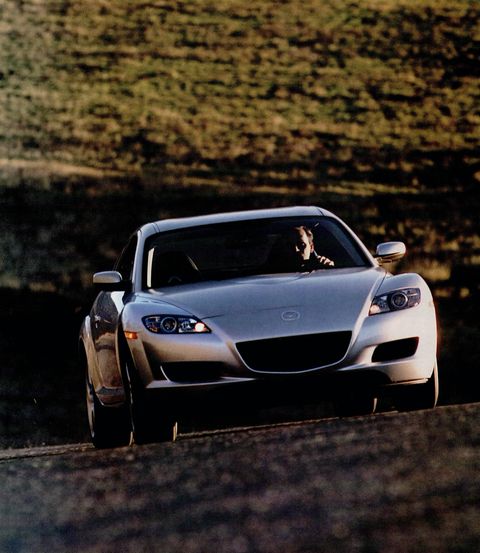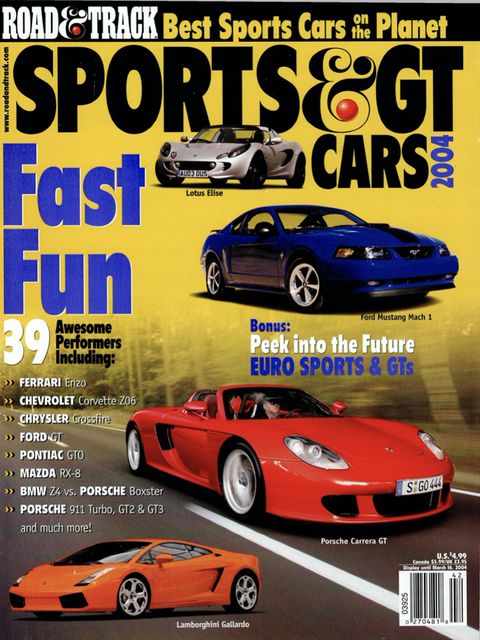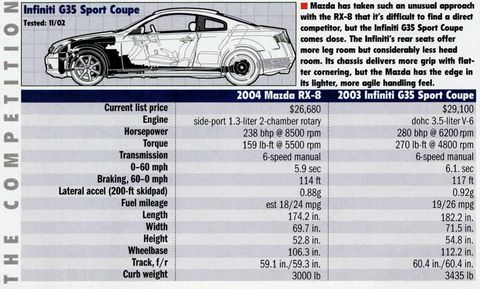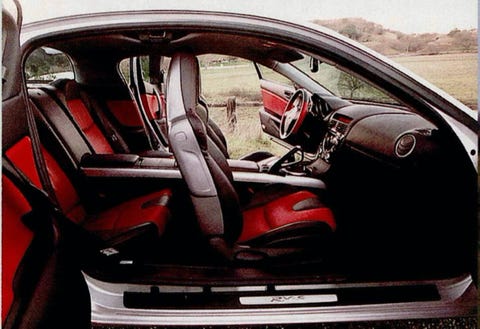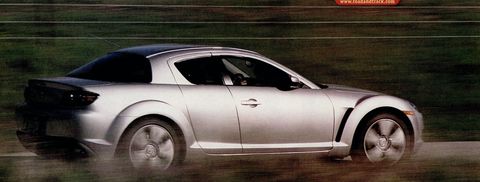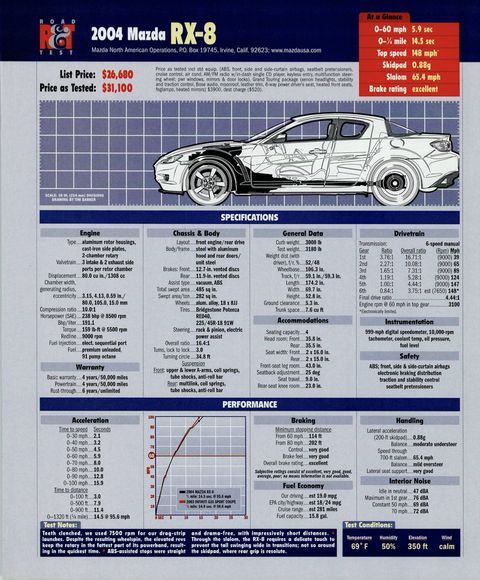The beep is back. It’s not exactly the tingly, joy-buzzer siren of the late, lamented RX-7 but rather a clear, solid tone that announces you’ve reached the rarefied redline of 9000 rpm. To fans of the rotary engine, it’s music far sweeter than any score composed by Chopin or Tchaikovsky. And this time around, the two-chamber rotary is packaged in the Mazda RX-8, a vehicle that forces us to reexamine the definition of sports car—call it “variation on a rotary theme.”
Progeny of both the RX-Evolv and RX-01 show cars, the Hiroshima-built RX-8 isn’t meant to be a direct replacement for the RX-7—although Mazda is not ruling out the possibility of a successor. Rather, it’s a very capable-handling, affordable rear-drive sports car with room for four people, with ingenious doors to admit those people. It’s powered by a new version of the rotary engine called Renesis, whose 238-bhp output approaches that of the third-generation RX-7’s, yet without its twin turbochargers, higher emissions and thirst for fuel. Credit a new design that eliminates the peripheral exhaust ports, moving them instead to the cast-iron side plates in the rotary’s Dagwood-sandwich construction, which alternates these plates with the two aluminum rotor housings. The Renesis design allows for 30-percent-larger intake ports and no overlap between intake and exhaust, which means that unburned hydrocarbons are carried into the next combustion cycle rather than simply coughed out the exhaust ports.
This story originally appeared in the 2004 Sports & GT Cars issue of Road & Track.
SIGN UP FOR THE TRACK CLUB BY R&T FOR MORE EXCLUSIVE STORIES
RX-8s come in two basic configurations. Want clutchless ease? Then $25,180 buys you a version with 197 bhp and a 4-speed automatic, with sequential shifts summoned through paddles on the small-diameter 3-spoke steering wheel. The automatic version’s lower output is traceable to rpm limitations of the torque converter, restricting engine speed to 7500 rpm, though its peak torque is actually higher than the more powerful engine— 164 lb.-ft. at 5000rpm, versus 159 lb.-ft. at 5500. The automatic car also has smaller brake rotors, a 16-in. wheel/tire package and slightly more compliant suspension, although the larger brakes, wheel/tire package and sport suspension can be ordered as options.
For the full 9000-rpm, 238-bhp rush, look to our 6-speed manual-equipped test car whose $26,680 base price gets bumped to $31,100 with just about every conceivable option: xenon headlights, foglights, heated leather seats, a crisp-sounding Bose audio system with a CD changer and a power moonroof. Its Renesis rotary gets a third intake port for each rotor (versus the automatic version’s two) that pipes in at the 6250-rpm transition point of its complex, variable-volume intake system for improved high-rpm breathing. Along with firmer suspension, a slightly larger front anti-roll bar (26.5 mm versus 25.4) and 5-spoke 18 x 8 -in. wheels mounting 225/45R-18 Bridgestone Potenza RE040 tires, the 6-speed car also has bigger brakes (12.7-in. front rotors,11.9-in. rears). Mazda’s DSC stability control is an option.
With either RX-8, the novelty here (besides the rotary engine) is that you can take three friends along on your sports-car experience in reasonable comfort, especially in the head-room department. Its Freestyle door system (Mazda’s term) consists of conventional front doors, and rear-hinged rear doors that swing out 80 degrees, creating an opening so large it resembles one of those cutaway interior bucks you see at auto shows. It also begs the question of how the RX-8 would fare in a side impact. The answer? Quite well, as Mazda has incorporated a “virtual B-pillar” of tubular steel inside the largely aluminum rear doors that spreads crash loads to the rocker panels and roof. Additionally, there are the usual internal side beams, pins and latches along the tops and bottoms of the doors that engage in corresponding sockets on impact to minimize intrusion. A full complement of side curtain, thorax and frontal airbags reduces the danger further still.
Part of Mazda’s self-described feeling of “comfortable snugness” in the RX-8’s cockpit comes from its high, full-length center tunnel, a reinforced backbone structure that adds rigidity to the unit body and makes the unusual doors possible. On either side are nicely supportive, thin-shell front seats, each incorporating a rotor shaped trim piece in the integral headrest. The rotor motif appears in several other places, but is most exquisitely rendered on the shift knob. The driver faces a serious set of gauges, the large center-mounted tach having an inset digital speedometer. In a siamesed dial to the right, oil pressure; to the left, coolant temperature and fuel. Both the instantly decipherable climate-control knobs and stereo controls are integrated into a single panel whose lustrous black finish resembles Japanese lacquered wood—a handsome treatment also used on the door panels for the window switches. Along with high-quality plastics, touches of chrome and contrasting inserts for the door panels and seats, it’s a remarkably well-finished and appealing interior at this, or any, price point.
In the rear seats, passengers will a) experience mild claustrophobia or b) feel like junior executives being whisked to their destination in a small private jet, due to the curvature of the roof and view out the smallish side windows that tilt out for ventilation. Remove a plastic panel between the seats, and a pass-through to the trunk is revealed. The trunk itself, though narrow of aperture, is deep and wide enough to hold two standard golf bags. Part of the volume is due to the lack of a spare tire, but a small kit containing a compressor and fix-flat goo is included.
The driver’s seat, of course, is the one to have. If you’re looking for the edgy, visceral thrill of the RX-7, you might be slightly disappointed; the RX-8 barters a measure of that sports car’s white-knuckle aggression for an extra dose of real-world civility. There’s impressive hardware underneath to make that happen: a classic double-wishbone front suspension with forged aluminum arms, and all-new 5-link rear suspension; and in a page borrowed from the Miata and RX-7, a more rigid, closed-section truss that connects the transmission and Torsen-type differential and parallels the one-piece carbon-fiber driveshaft. Combine this with an engine placed 1.6 in. lower and 2.4 in. farther back than in the RX-7, and one should have a car that’s agile and changes direction quickly.
One does. But first, twist the key to experience the near-vibrationless character of the rotary. Even at idle, the 2-rotor emits a unique, chirpy murmur. As revs increase, there’s a muffled, bandsaw-through-fiberglass wail as the tach soars to 9000 rpm. Even at redline it’s quite smooth compared with its piston counterpart, because for every revolution of its eccentric shaft (the crankshaft’s cousin in a rotary), each rotor has made a leisurely one-third turn. It doesn’t deliver a super-torquey feel like Nissan’s 350Z, for example, but the power swells with rpm, and the close-ratio 6-speed with sublimely compact throws makes keeping this engine on boil a delight. Like a Honda S2000 with its similarly elevated revs, it truly engages you in the driving experience.
With a tire-smoking launch (best times were achieved dropping the clutch at about 7500 rpm), the RX-8 in our testing sees 60 mph in 5.9 seconds and charges through the quarter in 14.5 sec. at 95.6 mph— a match for the Porsche Boxster and certainly quick by modern sports-car standards. Rather than ear-pinning straight-line acceleration, though, it’s the overall balance and coordination of this chassis coupled with the Renesis’ inimitable delivery of power that make the RX-8 so rewarding to drive.
Stab the brakes and there’s a reassuring firmness to the aluminum-capped pedal. Load up the suspension fully in a turn and discover 0.88g of grip, albeit accompanied by some very un-RX-7-like roll softness that’s a tradeoff for its relatively supple ride. (If you’ve ever driven a third-generation RX-7, you know that a kidney-friendly ride quality was not its strong suit.) Steer into the mildest of kinks or a wrist-crosser of a hairpin, and there’s precision feedback from the electrically-assisted rack, and a nice linear gain of effort the farther the steering wheel is turned. Everything works in satisfying harmony, building to limits in a predictable way. Exceed those limits and you won’t be punished with snap oversteer or irretrievable push. Said another way, if you drive it in the toss-and-catch mode, the catching is easy.
So what we have here is an excellent, civilized sports car that just happens to have four doors. A bit of an enigma, perhaps, but a thoroughly fresh concept that is practical enough for some people to rationalize a sports-car purchase, especially considering its temptingly low price. Quoting ourselves, from Road & Track’s own Illustrated Automotive Dictionary: “In truth, these days a sports car can include almost any performance car that is exhilarating to drive and puts a smile on the driver’s face.” Judging from the Cheshire cat expressions of everyone around here who’s revved its 2-rotor with enthusiasm, the RX-8 wholeheartedly qualifies.
